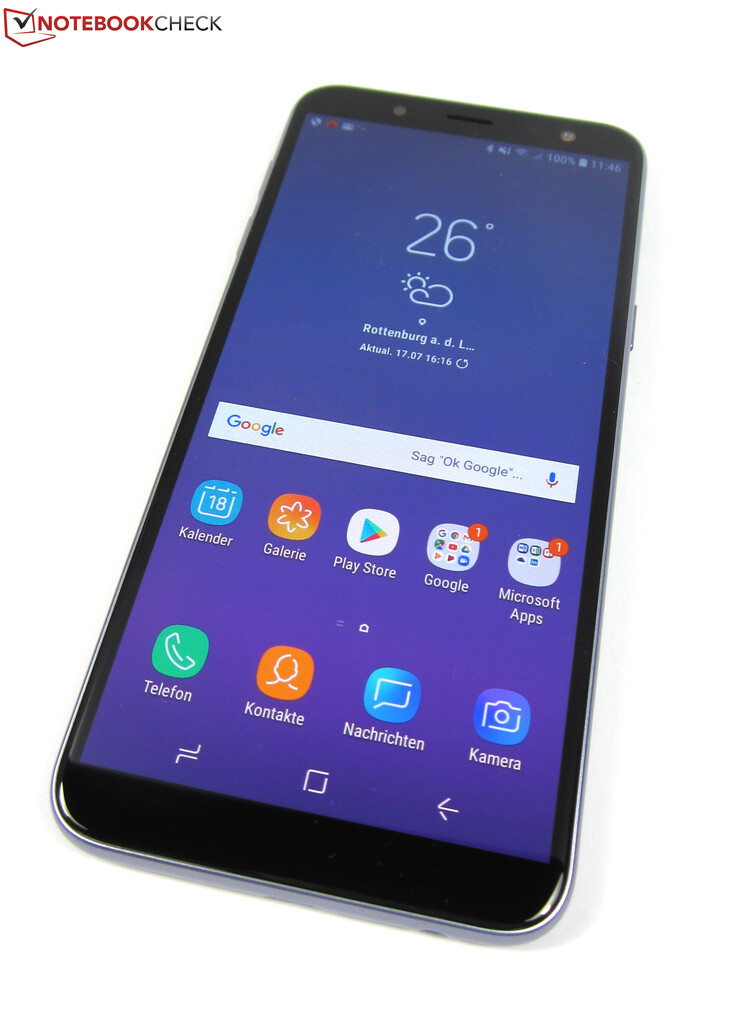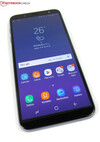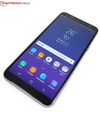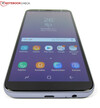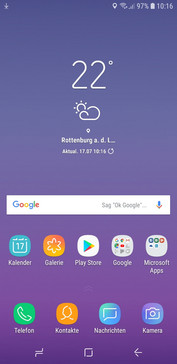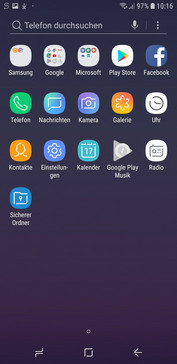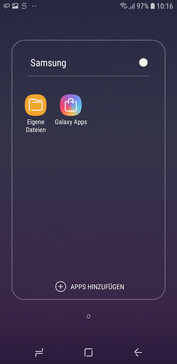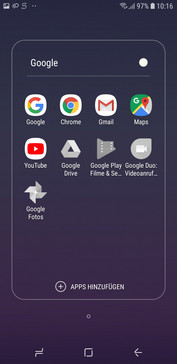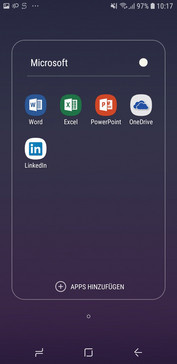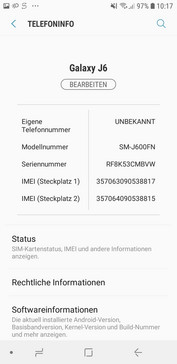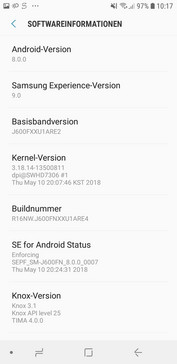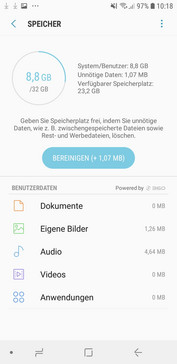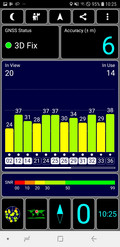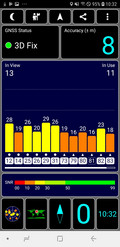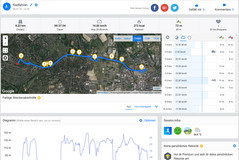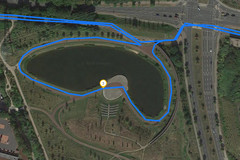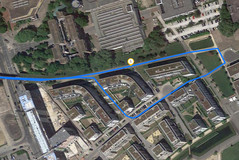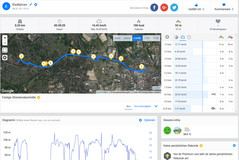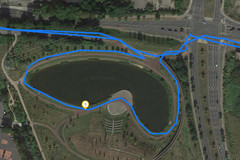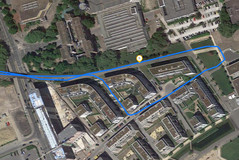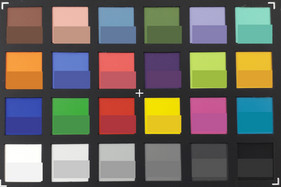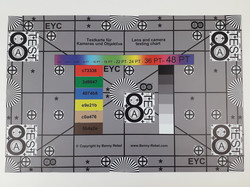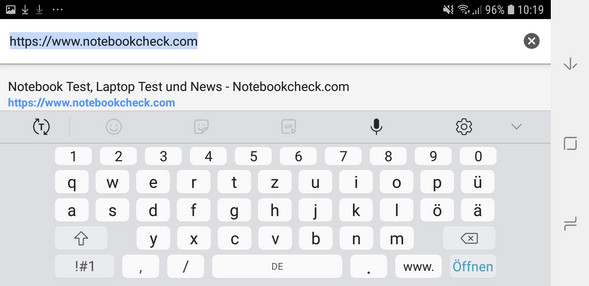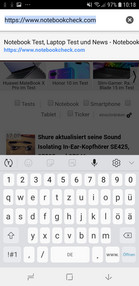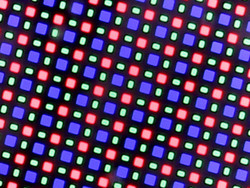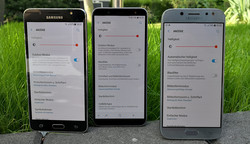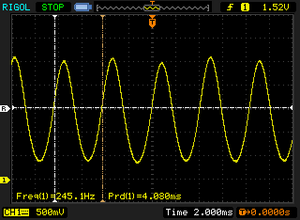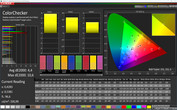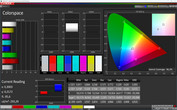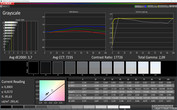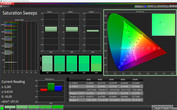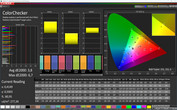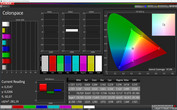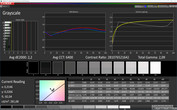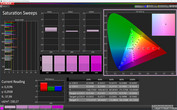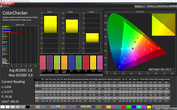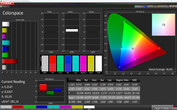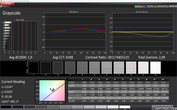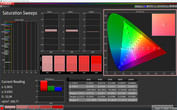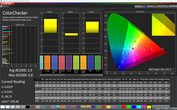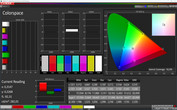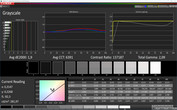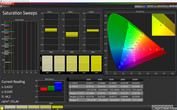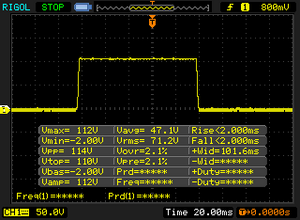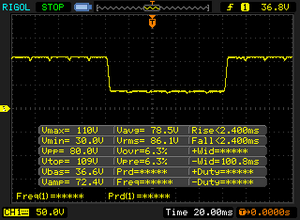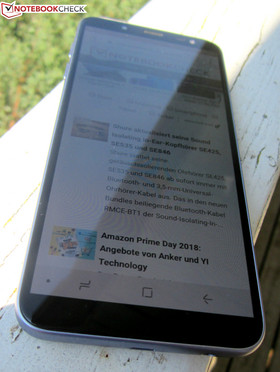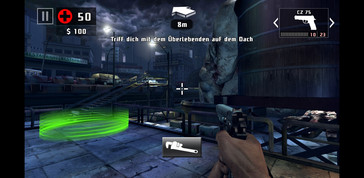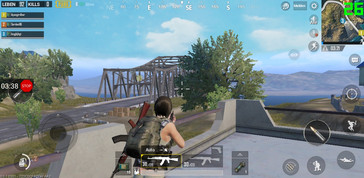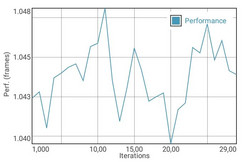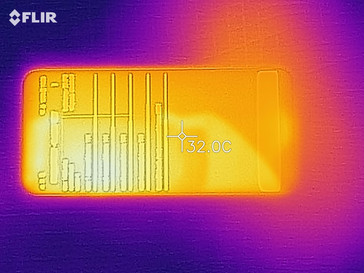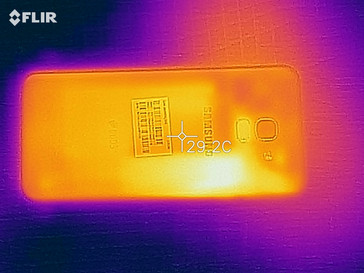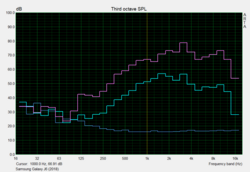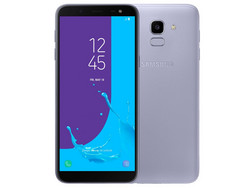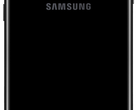Samsung Galaxy J6 (2018) Smartphone Review

The Samsung J6 (2018) is another addition to the plentiful Galaxy family. While the J6 (2018) has no direct predecessor, the entry-level device is practically a successor to the Samsung Galaxy J5 (2017) in terms of features and performance. The J6 (2018) costs 269 Euros (~$313) at launch.
The highlight of the J6 (2018) is its 5.6-inch Super AMOLED 720p display. It is worth bearing in mind though that many similarly priced devices are equipped with 1080p displays. The J6 (2018) also has a fingerprint sensor and a 13 MP camera on the rear of the device and an 8 MP front-facing camera. Added to that is its octa-core Samsung Exynos 7870 Octa SoC, 3 GB of RAM and 32 GB of internal storage. The J6 (2018) ships with Android Oreo 8.0. The device even has dedicated microSD card and dual nano-SIM card slots too.
We have chosen to compare the J6 (2018) with the Samsung Galaxy J5 (2017), its spiritual predecessor, and with the ASUS ZenFone 4 Selfie Pro ZD552KL, the Honor 7X, the Motorola Moto G6 Plus, the Nokia 6 (2018) and the Sony Xperia XA2. All our comparison devices cost around 300 Euros (~$350) and are equipped with equivalent hardware to the J6 (2018).
Update 8/6/18: Samsung has released a new update. Details can be found in the software section.
Case
The J6 (2018) has a plastic case, the workmanship of which is faultless; we could hardly bend our test device with repeated attempts. Plastic feels cheaper than the aluminum that Samsung used for the J5 (2017) though, so the J6 (2018) is a step down in that regard. The J6 (2018) is comfortable in the hand too thanks to its rounded back cover.
The fingerprint sensor is below the rear-facing camera, which is a change from its home button integration on the J5 (2017). The physical home button has been removed in favor of a higher screen-to-body ratio. The J6 (2018) uses the standard set of three onscreen buttons within the navigation bar instead.
The J6 (2018) has thinner top and bottom bezels than the J5 (2017). This means that the J6 (2018) has a 1480x720 resolution display, which is 200 pixels more on its Y axis than the 1280x720 resolution used on the J5 (2017).
The J6 (2018) feels slimmer and more elegant than its predecessor too thanks to it being 1 mm narrower and 3 mm taller.
The J6 (2018) is available black, gold, lavender and silver.
Connectivity
The J6 (2018) scores highly for being a dual-SIM device. Better still, the device has dedicated nano-SIM and microSD card slots. This means that there is no compromise between a second SIM and a microSD card as there is in some other dual-SIM devices. The J6 (2018) supports up to 256 GB microSD cards and can format them as internal storage. Samsung includes 15 GB of its cloud storage service too.
The J6 (2018) comes with 32 GB eMMC flash storage, of which 23.2 GB is usable with the remainder reserved for the OS and its ancillary services.
The first sign that we are dealing with an entry-level device is the Micro USB port. USB Type-C is fast becoming a standard in modern smartphones thanks to its reversibility and theoretically faster transfer speeds. The J6 (2018)’s Micro USB port is USB 2.0 and supports USB On-The-Go (OTG).
Software
The J6 (2018) ships with Android Oreo 8.0, on top of which Samsung adds its Experience 9.0 UI. Samsung makes no fundamental changes from stock Android, so most users will get accustomed to the device quickly.
Our test device came with Android security patch level May 1, 2018, which was around 10 weeks old at the time of testing.
Update 8/6/18: Samsung has released a 333 MB large OTA update which is supposed to improve GDPR compliance. In addition, the email client’s and Bluetooth connectivity stability have been improved. Google’s security patches have been updated and are now as of July 1st, 2018.
Communication & GPS
Broadly speaking, the J6 (2018) improved on the J5 (2017)’s mobile Internet capabilities, but it has taken a step backwards in terms of Wi-Fi performance.
Both devices use LTE Cat. 6, which supports a theoretical 300 Mb/s uplink along with features like VoLTE and VoWiFi. The J6 (2018) excels in its LTE support though, with its 11 LTE bands trumping the J5 (2017)’s seven. This degree of LTE support makes the J6 (2018) suitable for using outside of Europe, but the device cannot be considered a true globetrotter.
As mentioned above, the J6 (2018) has worse Wi-Fi capabilities and performance than its predecessor. Whereas the J5 (2017) supports IEEE 802.11 a/b/g/n/ac, the J6 (2018) only supports b/g/n. In practical terms, this means that the J6 (2018) can only connect to 2.4 GHz Wi-Fi networks, while the J5 (2017) can connect to both 2.4 and 5 GHz networks.
To make matters worse, the J6 (2018) finished last in our iperf3 Client Wi-Fi tests and is significantly slower than its predecessor. Our test device achieved a paltry 44.3 Mb/s in the iperf3 transmit test and 43.8 Mb/s in the iperf3 receive test, which is about a sixth of the speed that the J5 (2017) achieved.
The J6 (2018) uses GPS, GLONASS and BeiDou for location services. Our test device took a few moments to fix a location irrespective of being inside or outside. GPS accuracy is marginally better outside than inside as you would expect, with our test device achieving a GPS accuracy of up to six meters outside and eight meters inside.
We took the J6 (2018) on a bike ride to test its location accuracy against a professional navigation device, the Garmin Edge 500. Our test device performed well, recording the course accurately and only deviating by 30 meters over a 9.25 km ride. Our test device even plotted our route more precisely in some instances than the Garmin, a feat that is particularly impressive given the former’s price. Overall, the J6 (2018) should be suitable for all general navigation tasks and even those where higher precision is required.
Telephone Function & Call Quality
The J6 (2018) is a dual-SIM device and supports assigning calls, data services and messages to specific SIM cards if necessary. The phone app is arranged by tabs for the keypad, recent calls and contacts.
Call quality is good for a device at this price with no dropouts or other such disturbances. There is no noise cancellation though, so we would recommend looking for a quiet place from which to make calls. This applies when making calls with the included headphones too, as these do not support noise cancellation either. The headphones included with our test device are EHS61ASFWE.
Cameras
The J6 (2018) has a 13 MP rear-facing camera and an 8 MP front-facing one. Notably, the J6 (2018) has a lower resolution front-facing camera than the J5 (2017), which has a 13 MP front-facing camera.
The 8 MP front-facing camera has an f/1.9 aperture and takes photos in up to 3264x2448 in 4:3 and 2560x1440 in 16:9. The stock camera app includes numerous effects like selfie-focus, which blurs the background of a shot to give a bokeh effect, a group selfie mode and sticker mode, which overlays stickers onto shots. The front-facing camera takes good photos in good light and is supported by a triple LED flash for when taking shots in low-light.
The camera also records video in up to 1080p at 30 FPS.
The 13 MP rear-facing camera also has an f/1.9 aperture, which is smaller than the f/1.7 aperture sensor used in the J5 (2017). In practical terms, this means that the sensor in the J6 (2018) lets in less light than its predecessor.
According to AIDA64, a camera diagnostic tool, the rear-facing camera sensor is the SLSI_25K3L2, which Samsung used in the Galaxy J5 (2016). In effect, Samsung is reusing old camera technology in the J6 (2018) and is not opting for the newer sensors that are used in the J5 (2017).
The rear-facing camera takes good photos in daylight conditions, as represented by scenes 1 and 2, but videos look washed out because of the camera’s limited dynamic range. Low-light conditions highlight the deficiencies of the relatively small aperture though, an example of which we have included as scene 3. The J6 (2018) can still capture some fine details, but the example image is poorly exposed and dominated by noise.
We then subjected the J6 (2018) to camera tests under controlled lighting conditions. During these tests, we photograph a test chart that simulates difficult details for cameras to accurately capture like fine lines or text against a colored background. We then use X-Rite ColorChecker Passport to check color image accuracy.
The J6 (2018) generally oversaturates colors like many other smartphones but still manages to be in line with the target color space. The J6 (2018) did a good job of reproducing our test chart, but the result is not uniformly sharp.
Accessories & Warranty
The J6 (2018) comes with a USB Type-A to Micro USB cable, a 5V/1A modular charger, a set of headphones, a SIM and a quick-start guide. Samsung does not currently offer any J6 (2018) specific accessories.
The J6 (2018) comes with a 24-month manufacturer warranty. Please see our Guarantees, Return policies and Warranties FAQ for country-specific information.
Input Devices & Operation
Our test device’s Super AMOLED display has a five-point multitouch touchscreen that responds accurately and precisely to inputs. The volume rocker and power button wiggle in their housings though, which feels cheap.
The fingerprint sensor and facial recognition unlock the device quickly and reliably. Your fingerprint can be used to authorize both Samsung Pass and the Secure Folder app, the latter of which can hide apps and content from third parties. Samsung Pass is much like other password managers and allows you to log in to websites and apps without inputting your credentials.
Samsung includes some other additional functionality too. Among these features are a one-handed mode, a camera quick-start button combination, a split-screen mode and the option to not only customize dual-SIM functionality but also to separate your professional and private life into two separate user accounts. The latter of these allows you to be logged into your personal Facebook account on one user account and your professional Facebook account on the other, for instance.
The preinstalled Samsung keyboard has text suggestions, text-to-speech and text shortcuts among other features too.
Display
The J6 (2018) has a 5.6-inch Super AMOLED display that has a 1480x720 native resolution and a pixel density of 294 PPI. Samsung markets the device as being equipped with an HD+ display. However, this just denotes the extra 200 pixels that the display has on its y-axis compared to traditional 720p displays with 16:9 aspect ratios that have a 1280x720 resolution. In short, this is just marketing. The J6 (2018) still has a 720p HD display.
This resolution is adequate for daily use but there are many devices that have sharper displays at a similar price. The ASUS ZenFone 4 Selfie Pro, the Sony Xperia XA2 and the Nokia 6 (2018) all have 1920x1080 displays, while the Moto G6 Plus and the Honor 7X have even sharper 2160x1080 displays. Content will look crisper on these displays than on the J6 (2018), but potentially at the cost of battery life.
Our test device achieved an average maximum brightness of 294.1 cd/m² as recorded by X-Rite i1Pro2, with some areas of the display achieving 307 cd/m². Interestingly, when we repeated the test with APL50, which measures average maximum luminosity by uniformly distributing dark and light areas across the display, our test device achieved 535 cd/m². Our test device scored 445 cd/m² with the outdoor mode activated too.
There are two problems with the display though, the seriousness of which may vary from user to user. Firstly, the J6 (2018) uses pulse-width modulation (PWM) to regulate display brightness. We measure PWM at 245.1 Hz, which is a relatively low frequency. This frequency should be low enough so that even those who are PWM-sensitive do not feel any ill effects. We cannot guarantee this though, so some users could still potentially suffer from eye-strain and headaches when using the device.
Worse still in our opinion is the lack of a brightness sensor, which is practically standard for current smartphones. This means the J6 (2018) has no auto-brightness, so you only have the option to manually adjust brightness. This is an absurd decision for a device released in 2018 that costs almost 300 Euros (~$350).
| |||||||||||||||||||||||||
Brightness Distribution: 93 %
Center on Battery: 296 cd/m²
Contrast: ∞:1 (Black: 0 cd/m²)
ΔE ColorChecker Calman: 2.8 | ∀{0.5-29.43 Ø4.79}
ΔE Greyscale Calman: 1.9 | ∀{0.09-98 Ø5}
96.3% sRGB (Calman 2D)
Gamma: 2.09
CCT: 6398 K
| Samsung Galaxy J6 2018 Super AMOLED, 1480x720, 5.6" | Asus ZenFone 4 Selfie Pro ZD552KL AMOLED, 1920x1080, 5.5" | Motorola Moto G6 Plus IPS, 2160x1080, 5.9" | Samsung Galaxy J5 (2017) Duos Super AMOLED, 1280x720, 5.2" | Sony Xperia XA2 IPS, 1920x1080, 5.2" | Huawei Honor 7X IPS, 2160x1080, 5.9" | Nokia 6 2018 IPS, 1920x1080, 5.5" | |
|---|---|---|---|---|---|---|---|
| Screen | -46% | 61% | 20% | -44% | 14% | -55% | |
| Brightness middle (cd/m²) | 296 | 456 54% | 761 157% | 448 51% | 513 73% | 533.2 80% | 417 41% |
| Brightness (cd/m²) | 294 | 455 55% | 723 146% | 451 53% | 506 72% | 511 74% | 421 43% |
| Brightness Distribution (%) | 93 | 85 -9% | 90 -3% | 91 -2% | 93 0% | 88 -5% | 88 -5% |
| Black Level * (cd/m²) | 0.69 | 0.42 | 0.35 | 0.61 | |||
| Colorchecker dE 2000 * | 2.8 | 5.6 -100% | 2.4 14% | 2.7 4% | 5 -79% | 2.83 -1% | 6.1 -118% |
| Colorchecker dE 2000 max. * | 9.8 | 11.1 -13% | 5.2 47% | 9.8 -0% | 11.4 -16% | 6.72 31% | 11.2 -14% |
| Greyscale dE 2000 * | 1.9 | 6.9 -263% | 1.8 5% | 1.6 16% | 7.8 -311% | 3.7 -95% | 7.1 -274% |
| Gamma | 2.09 105% | 2.3 96% | 2.21 100% | 2.06 107% | 2.2 100% | 1.9 116% | 2.16 102% |
| CCT | 6398 102% | 7883 82% | 6312 103% | 6557 99% | 7964 82% | 6918 94% | 8362 78% |
| Contrast (:1) | 1103 | 1221 | 1523 | 684 |
* ... smaller is better
Screen Flickering / PWM (Pulse-Width Modulation)
| Screen flickering / PWM detected | 245.1 Hz | ||
The display backlight flickers at 245.1 Hz (worst case, e.g., utilizing PWM) . The frequency of 245.1 Hz is relatively low, so sensitive users will likely notice flickering and experience eyestrain at the stated brightness setting and below. In comparison: 53 % of all tested devices do not use PWM to dim the display. If PWM was detected, an average of 8163 (minimum: 5 - maximum: 343500) Hz was measured. | |||
AMOLED and OLED displays can individually turn off pixels, which gives the J6 (2018) a perfect black value and a theoretically infinite contrast ratio. Devices with IPS LCD displays cannot compete in this regard.
The J6 (2018) does a great job in other areas of color accuracy and fidelity too. Our test device has 93% brightness uniformity, which equals the best of our comparison devices. Likewise, DeltaE deviations are better than the ideal value of three when using either the AMOLED Photo or AMOLED Cinema screen modes. Moreover, the color temperature is practically ideal at 6,400 K.
The Simple screen mode is closest to optimal values, while the standard Adaptive mode has slightly larger deviations from the target colour space. These deviations are hardly perceptible to the naked eye though.
Display Response Times
| ↔ Response Time Black to White | ||
|---|---|---|
| 4 ms ... rise ↗ and fall ↘ combined | ↗ 2 ms rise | |
| ↘ 2 ms fall | ||
| The screen shows very fast response rates in our tests and should be very well suited for fast-paced gaming. In comparison, all tested devices range from 0.1 (minimum) to 240 (maximum) ms. » 14 % of all devices are better. This means that the measured response time is better than the average of all tested devices (20.3 ms). | ||
| ↔ Response Time 50% Grey to 80% Grey | ||
| 4.8 ms ... rise ↗ and fall ↘ combined | ↗ 2.4 ms rise | |
| ↘ 2.4 ms fall | ||
| The screen shows very fast response rates in our tests and should be very well suited for fast-paced gaming. In comparison, all tested devices range from 0.165 (minimum) to 636 (maximum) ms. » 15 % of all devices are better. This means that the measured response time is better than the average of all tested devices (31.7 ms). | ||
The J6 (2018) is well suited for outdoor use thanks to its Super AMOLED and bright display. You will still struggle with reflections in bright sunlight though because of the display’s glossy finish.
Our test device has strong viewing angles too, with only minimal losses in brightness and color fidelity at acute angles. This is typical of OLED displays though.
Performance
The J6 (2018) and the J5 (2017) share the same Samsung Exynos 7870 Octa SoC. The Exynos 7870 integrates an octa-core ARM Cortex-A53 that is manufactured using 14 nm FinFET technology. There is an ARM Mali-T830 MP1 GPU too. The J6 (2018) has 3 GB of RAM and 32 GB of internal storage, which is 1 GB more RAM and 16 GB more internal storage than its predecessor.
The J6 (2018) is powerful enough for daily use, but we did notice some small delays immediately after booting or when switching between apps. Our test device cannot compete with many of our comparison devices in benchmarks, but it always edges out the J5 (2017).
Web-browsing feels snappy on our test device, which is something that browser benchmarks confirm. The J6 (2018) finishes near the bottom of our comparison devices in these benchmarks and is even beaten by the J5 (2017) in WebXPRT.
| JetStream 1.1 - Total Score | |
| Huawei Honor 7X (Chrome 63.0.3239.111) | |
| Nokia 6 2018 (Browser: Chrome 65) | |
| Motorola Moto G6 Plus (Chrome 66) | |
| Asus ZenFone 4 Selfie Pro ZD552KL (Chrome 64) | |
| Sony Xperia XA2 (Chrome 65.0.3325.109) | |
| Samsung Galaxy J5 (2017) Duos (Samsung Browser 5.4) | |
| Average Samsung Exynos 7870 Octa (20.8 - 26.4, n=8) | |
| Samsung Galaxy J6 2018 (Chrome 67.0.3396.87) | |
| Octane V2 - Total Score | |
| Average of class Smartphone (2228 - 121337, n=200, last 2 years) | |
| Huawei Honor 7X (Chrome 63.0.3239.111) | |
| Motorola Moto G6 Plus (Chrome 66) | |
| Nokia 6 2018 (Browser: Chrome 65) | |
| Samsung Galaxy J5 (2017) Duos (Samsung Browser 5.4) | |
| Asus ZenFone 4 Selfie Pro ZD552KL (Chrome 64) | |
| Sony Xperia XA2 (Chrome 65.0.3325.109) | |
| Average Samsung Exynos 7870 Octa (3721 - 4968, n=8) | |
| Samsung Galaxy J6 2018 (Chrome 67.0.3396.87) | |
| Mozilla Kraken 1.1 - Total | |
| Samsung Galaxy J6 2018 (Chrome 67.0.3396.87) | |
| Sony Xperia XA2 (Chrome 65.0.3325.109) | |
| Nokia 6 2018 (Browser: Chrome 65) | |
| Motorola Moto G6 Plus (Chrome 66) | |
| Asus ZenFone 4 Selfie Pro ZD552KL (Chrome 64) | |
| Average Samsung Exynos 7870 Octa (6784 - 11916, n=8) | |
| Huawei Honor 7X (Chrome 63.0.3239.111) | |
| Samsung Galaxy J5 (2017) Duos (Samsung Browser 5.4) | |
| Average of class Smartphone (257 - 28190, n=155, last 2 years) | |
| WebXPRT 2015 - Overall | |
| Nokia 6 2018 | |
| Huawei Honor 7X (Chrome 63.0.3239.111) | |
| Motorola Moto G6 Plus (Chrome 66) | |
| Sony Xperia XA2 (Chrome 65.0.3325.109) | |
| Samsung Galaxy J6 2018 (Chrome 67.0.3396.87) | |
| Samsung Galaxy J5 (2017) Duos (Samsung Browser 5.4) | |
| Average Samsung Exynos 7870 Octa (64 - 91, n=8) | |
* ... smaller is better
The J6 (2018) has 32 GB of eMMC flash storage, which is typical for a device at this price. Our test device struggles here too and is at the bottom of the pile with the J5 (2017) for company. The Moto G6 Plus is particularly fast in this regard.
Our test device holds its own in the microSD portion of AndroBench 3-5 though. We test all our devices with a Toshiba Exceria Pro M501 microSD card where possible, the theoretical read and writes speeds of which are 270 MB/s and 150 MB/s respectively. The J6 (2018) scored an average of 81.8 MB/s sequential read and 65.9 MB/s sequential write speeds. These are nowhere near the card’s theoretical speeds, but they do put the J6 (2018) ahead of many of our comparison devices.
| Samsung Galaxy J6 2018 | Asus ZenFone 4 Selfie Pro ZD552KL | Motorola Moto G6 Plus | Samsung Galaxy J5 (2017) Duos | Sony Xperia XA2 | Huawei Honor 7X | Nokia 6 2018 | Average 32 GB eMMC Flash | Average of class Smartphone | |
|---|---|---|---|---|---|---|---|---|---|
| AndroBench 3-5 | 19% | 112% | -21% | 22% | 38% | 19% | 21% | 1582% | |
| Sequential Read 256KB (MB/s) | 206.5 | 269.3 30% | 286.6 39% | 204.4 -1% | 271.5 31% | 265.3 28% | 272.6 32% | 242 ? 17% | 2216 ? 973% |
| Sequential Write 256KB (MB/s) | 100.5 | 139.5 39% | 216.1 115% | 52 -48% | 127.4 27% | 127.9 27% | 118.3 18% | 100.5 ? 0% | 1832 ? 1723% |
| Random Read 4KB (MB/s) | 27.05 | 36.8 36% | 58.4 116% | 24.07 -11% | 43.07 59% | 81.4 201% | 38.78 43% | 43.1 ? 59% | 293 ? 983% |
| Random Write 4KB (MB/s) | 12.37 | 12 -3% | 62.8 408% | 9.9 -20% | 13.82 12% | 20.24 64% | 15.3 24% | 22.3 ? 80% | 340 ? 2649% |
| Sequential Read 256KB SDCard (MB/s) | 81.8 ? | 83.9 ? 3% | 83.7 ? 2% | 72.2 ? -12% | 86 ? 5% | 52.7 -36% | 83.4 ? 2% | 71.8 ? -12% | |
| Sequential Write 256KB SDCard (MB/s) | 65.8 ? | 72.1 ? 10% | 62.1 ? -6% | 44.21 ? -33% | 64.8 ? -2% | 30.55 -54% | 61.3 ? -7% | 52.9 ? -20% |
Games
Graphics are handled by an ARM Mali-T830 MP1 GPU. Less graphically demanding games like Dead Trigger 2 play smoothly at maximum graphics. However, more complex titles like PUGB Mobile show the J6 (2018)'s graphical limitations. Our test device averaged 26 FPS on the “Liquid” preset, but it only managed 10 FPS on the “Balanced” preset; this is unplayable.
| PUBG Mobile | |||
| Settings | Value | ||
| Balanced | 10 fps | ||
| Dead Trigger 2 | |||
| Settings | Value | ||
| high | 60 fps | ||
Emissions
Temperature
The J6 (2018) is a relatively cool device, even under load. After one hour of stress testing, surface temperatures reach 34.8 °C on the back of the device and a maximum of 32.9 °C on the front. Our test device averages around 26 °C at idle too.
What’s more, the J6 (2018) manages heat well internally too. Our test device experienced no thermal throttling during our stress tests and maintained a consistent frame rate during the GFXBench battery test in which the T-Rex and Manhattan benchmarks are rendered 30 times on a loop.
(+) The maximum temperature on the upper side is 32.9 °C / 91 F, compared to the average of 35.2 °C / 95 F, ranging from 21.9 to 247 °C for the class Smartphone.
(+) The bottom heats up to a maximum of 34.8 °C / 95 F, compared to the average of 34 °C / 93 F
(+) In idle usage, the average temperature for the upper side is 25.9 °C / 79 F, compared to the device average of 32.9 °C / 91 F.
Speakers
The speaker is on the right-hand side of the device, the positioning of which makes it hard to obscure the speaker when holding the device in landscape mode.
The speaker in our test device reaches a maximum of 83.9 dB(A), which is marginally quieter than the J5 (2017). Sound quality is good for a device at this price, with voices sounding particularly clear and no noticeable distortion at maximum volume. Bass tones are lacking, but this is to be expected from most smartphone speakers.
Audio playback sounds much better when listening with the included headphones, but the sound quality occasionally sounds dull compared to other headphones.
Samsung Galaxy J6 2018 audio analysis
(+) | speakers can play relatively loud (83.9 dB)
Bass 100 - 315 Hz
(-) | nearly no bass - on average 24.6% lower than median
(±) | linearity of bass is average (10% delta to prev. frequency)
Mids 400 - 2000 Hz
(+) | balanced mids - only 4.1% away from median
(+) | mids are linear (6.6% delta to prev. frequency)
Highs 2 - 16 kHz
(±) | higher highs - on average 5.6% higher than median
(±) | linearity of highs is average (7.2% delta to prev. frequency)
Overall 100 - 16.000 Hz
(±) | linearity of overall sound is average (21.2% difference to median)
Compared to same class
» 39% of all tested devices in this class were better, 8% similar, 53% worse
» The best had a delta of 12%, average was 35%, worst was 134%
Compared to all devices tested
» 58% of all tested devices were better, 7% similar, 35% worse
» The best had a delta of 4%, average was 24%, worst was 134%
Samsung Galaxy J5 (2017) Duos audio analysis
(+) | speakers can play relatively loud (86.8 dB)
Bass 100 - 315 Hz
(-) | nearly no bass - on average 24.1% lower than median
(±) | linearity of bass is average (10.1% delta to prev. frequency)
Mids 400 - 2000 Hz
(+) | balanced mids - only 2.4% away from median
(+) | mids are linear (4.6% delta to prev. frequency)
Highs 2 - 16 kHz
(±) | higher highs - on average 6.2% higher than median
(+) | highs are linear (4.7% delta to prev. frequency)
Overall 100 - 16.000 Hz
(±) | linearity of overall sound is average (18.8% difference to median)
Compared to same class
» 21% of all tested devices in this class were better, 10% similar, 69% worse
» The best had a delta of 12%, average was 35%, worst was 134%
Compared to all devices tested
» 42% of all tested devices were better, 8% similar, 50% worse
» The best had a delta of 4%, average was 24%, worst was 134%
Motorola Moto G6 Plus audio analysis
(+) | speakers can play relatively loud (86.3 dB)
Bass 100 - 315 Hz
(-) | nearly no bass - on average 26.3% lower than median
(±) | linearity of bass is average (7.9% delta to prev. frequency)
Mids 400 - 2000 Hz
(+) | balanced mids - only 3.9% away from median
(+) | mids are linear (5.4% delta to prev. frequency)
Highs 2 - 16 kHz
(+) | balanced highs - only 4.6% away from median
(+) | highs are linear (5.1% delta to prev. frequency)
Overall 100 - 16.000 Hz
(±) | linearity of overall sound is average (18.7% difference to median)
Compared to same class
» 20% of all tested devices in this class were better, 9% similar, 70% worse
» The best had a delta of 12%, average was 35%, worst was 134%
Compared to all devices tested
» 41% of all tested devices were better, 8% similar, 51% worse
» The best had a delta of 4%, average was 24%, worst was 134%
Battery Life
Power Consumption
The J6 (2018) is a power-efficient device, with our test device consuming an average of 1.51 W at idle and 4.21 W under load. However, it cannot compete with the ASUS ZenFone 4 Selfie Pro or the J5 (2017), which are 30 and 39% more power-efficient than the J6 (2018), respectively. Only the Honor 7X consumes more power than the J6 (2018) out of our comparison devices.
The J6 (2018) has no quick-charge functionality. Unfortunately, this means that the included 5V/1A power supply takes almost three hours to fully recharge the device’s 3,000 mAh battery.
| Off / Standby | |
| Idle | |
| Load |
|
Key:
min: | |
| Samsung Galaxy J6 2018 3000 mAh | Asus ZenFone 4 Selfie Pro ZD552KL 3000 mAh | Motorola Moto G6 Plus 3200 mAh | Samsung Galaxy J5 (2017) Duos 3000 mAh | Sony Xperia XA2 3300 mAh | Huawei Honor 7X 3340 mAh | Nokia 6 2018 3000 mAh | Average Samsung Exynos 7870 Octa | Average of class Smartphone | |
|---|---|---|---|---|---|---|---|---|---|
| Power Consumption | 30% | 9% | 39% | 17% | -28% | 9% | 3% | -32% | |
| Idle Minimum * (Watt) | 0.85 | 0.58 32% | 0.5 41% | 0.52 39% | 0.39 54% | 1.02 -20% | 0.67 21% | 0.71 ? 16% | 0.856 ? -1% |
| Idle Average * (Watt) | 1.51 | 1.31 13% | 1.78 -18% | 1.17 23% | 1.61 -7% | 2.46 -63% | 1.76 -17% | 1.909 ? -26% | 1.437 ? 5% |
| Idle Maximum * (Watt) | 1.57 | 1.33 15% | 1.81 -15% | 1.24 21% | 1.62 -3% | 2.51 -60% | 1.78 -13% | 1.995 ? -27% | 1.612 ? -3% |
| Load Average * (Watt) | 4.21 | 1.88 55% | 3.3 22% | 1.66 61% | 3.12 26% | 4.16 1% | 2.82 33% | 3.02 ? 28% | 7.1 ? -69% |
| Load Maximum * (Watt) | 5.88 | 3.8 35% | 5.14 13% | 2.94 50% | 4.92 16% | 5.87 -0% | 4.56 22% | 4.42 ? 25% | 11.2 ? -90% |
* ... smaller is better
Battery Life
The J6 (2018) has impressively good battery life, but many of our comparison devices have longer runtimes. Our test device lasted nearly five hours under load but lasted almost 12 hours in our Wi-Fi battery life test in which we run a script that simulates the load required to render websites. Our test device lasted over 14 hours when playing an H.264 video. Overall, the J6 (2018) lasted longer than the ZenFone 4 Selfie Pro and the Honor 7X, but it could not match our other comparison devices, including its predecessor.
| Samsung Galaxy J6 2018 3000 mAh | Asus ZenFone 4 Selfie Pro ZD552KL 3000 mAh | Motorola Moto G6 Plus 3200 mAh | Samsung Galaxy J5 (2017) Duos 3000 mAh | Sony Xperia XA2 3300 mAh | Huawei Honor 7X 3340 mAh | Nokia 6 2018 3000 mAh | |
|---|---|---|---|---|---|---|---|
| Battery runtime | -8% | 5% | 16% | 20% | -22% | 14% | |
| Reader / Idle (h) | 24.9 | 30.8 24% | 26.1 5% | 41.7 67% | 18.5 -26% | 30.6 23% | |
| H.264 (h) | 14.5 | 9 -38% | 15.3 6% | 12.8 -12% | 11.3 -22% | ||
| WiFi v1.3 (h) | 11.8 | 10.9 -8% | 11.7 -1% | 12.3 4% | 14.8 25% | 11.1 -6% | 15.7 33% |
| Load (h) | 5 | 6.7 34% | 7.5 50% | 5 0% | 3.3 -34% | 6 20% |
Pros
Cons
Verdict
The Samsung Galaxy J6 (2018) is a good entry-level smartphone that is lacking in some crucial areas. Samsung relies too heavily on the weight of its Galaxy J series, to the extent that we recommend last year’s Galaxy J5 (2017) over the J6 (2018).
The Samsung Galaxy J6 (2018) is a good entry-level smartphone, but do not rush out to buy it; last year’s Galaxy J5 (2017) offers more features at half the cost.
There are many areas in which the J6 (2018) is more deficient than in its effective predecessor. While the case is well-crafted, it is made of plastic rather than the aluminum that Samsung used in the J5 (2017). Moreover, Samsung has removed 5 GHz Wi-Fi connectivity between generations, ditched auto brightness and used camera sensors from the J5 (2016). All these missteps hamper the J6 (2018) in daily use compared to its predecessor.
These issues make other decisions like the choice of SoC, the lack of USB Type-C, no fast charging and a 720p display more frustrating when considering what the competition now offers.
The J6 (2018) does some things well though. The device has dedicated microSD and dual nano-SIM card slots and a wealth of LTE coverage; significantly more so than the J5 (2017). Likewise, the J6 (2018) ships with Android Oreo 8.0 and has a precise GPS module. Finally, the device has good battery life, and its Super AMOLED display is both bright and color accurate.
Samsung Galaxy J6 2018
- 07/20/2018 v6 (old)
Manuel Masiero




